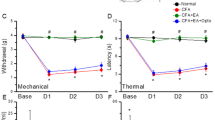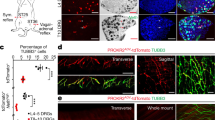Abstract
RECENT research has led to the hypothesis that acupuncture produces analgesia through the release of endorphins. In neurophysiological studies on single neurones in lamina 5 of cat spinal cord, electroacupuncture reduced responses to noxious stimuli, and the delays of this effect suggested a hormonal mediator1. Analgesia due to electroacupuncture on mice2 and acupuncture on humans3 can be prevented by the opiate receptor antagonist naloxone. These studies strongly suggest that endorphins may mediate the observed analgesia. Endorphins, specifically β-endorphin and the enkephalins, are peptides whose abilities to bind to opiate receptors4,5 and produce analgesia6–8 have been well characterised. The implication of endorphins in electroacupuncture analgesia has rested heavily on the ability of naloxone to block the acupuncture effect. Reliance on this single line of evidence has been criticised9, since naloxone may possess unknown activities unrelated to its opiate antagonist role. We show here that mice of the CXBK strain which are deficient in opiate receptors show poor electroacupuncture analgesia. This constitutes a naloxone-independent test of the hypothesis.
This is a preview of subscription content, access via your institution
Access options
Subscribe to this journal
Receive 51 print issues and online access
$199.00 per year
only $3.90 per issue
Buy this article
- Purchase on Springer Link
- Instant access to full article PDF
Prices may be subject to local taxes which are calculated during checkout
Similar content being viewed by others
References
Pomeranz, B., Cheng, R. & Law, P. Expl Neurol. 54, 172–178 (1977).
Pomeranz, B. & Chiu, D. Life Sci. 19, 1757–1762 (1976).
Mayer, D. J., Price, D. D. & Rafii, A. Brain Res. 121, 368–372 (1977).
Hughes, J., Smith, T., Morgan, B. & Fothergill, L. Life Sci. 16, 1753–1758 (1975).
Waterfield, A. A., Smokcum, R. W. J., Hughes, J., Kosterlitz, H. W. & Henderson, G. Eur. J. Pharmac. 43, 107–116 (1977).
Buscher, H. H. et al. Nature 261, 423–425 (1976).
Malick, J. B. & Goldstein, J. M. Life Sci. 20, 827–832 (1977).
Meglio, M. et al. Proc. natn. Acad. Sci. U.S.A. 74, 774–776 (1977).
Hayes, R., Price, D. D. & Dubner, R. Science 196, 600 (1977).
Baran, A., Shuster, L., Eleftheriou, B. E. & Bailey, D. W. Life Sci. 17, 633–640 (1975).
Brase, D. A., Loh, H. H. & Way, E. L. J. Pharmac. exp. Ther. 201, 368–374 (1977).
Eidelberg, E. et al. Eur. J. Pharmac. 32, 329–336 (1975).
Shuster, L., Webster, G. W., Yu, G. & Eleftheriou, B. E. Psychopharmacologia 42, 249–254 (1975).
Castellano, C. & Oliverio, A. Psychopharmacologia 41, 197–200 (1975).
Adams, J. E. Pain 2, 161–166 (1976).
Akil, H., Mayer, D. J. & Liebeskind, J. C. Science 191, 961–962 (1976).
Yeung, J. C., Yaksh, T. L. & Rudy, T. A. Pain 4, 23–40 (1977).
Author information
Authors and Affiliations
Rights and permissions
About this article
Cite this article
PEETS, J., POMERANZ, B. CXBK mice deficient in opiate receptors show poor electroacupuncture analgesia. Nature 273, 675–676 (1978). https://doi.org/10.1038/273675a0
Received:
Accepted:
Issue Date:
DOI: https://doi.org/10.1038/273675a0
This article is cited by
-
KAM-Verfahren in der Schmerztherapie – evidenzbasierter Diskurs notwendig
Der Schmerz (2023)
-
Wissenschaftliche Mängel im CME-Artikel zur Komplementärmedizin in der Schmerztherapie
Der Schmerz (2023)
-
Traditional Chinese medicine valuably augments therapeutic options in the treatment of climacteric syndrome
Archives of Gynecology and Obstetrics (2016)
-
Akupunktur in der endokrinologischen Gynäkologie
Gynäkologische Endokrinologie (2015)
-
Acupuncture for post anaesthetic recovery and postoperative pain: study protocol for a randomised controlled trial
Trials (2014)
Comments
By submitting a comment you agree to abide by our Terms and Community Guidelines. If you find something abusive or that does not comply with our terms or guidelines please flag it as inappropriate.



